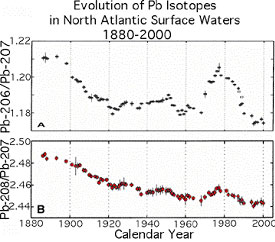
| Rationale:
This work aims to use the isotopic variability of trace metals to understand
mechanisms controlling the fluxes of metals through the ocean and their
links to biogeochemical processes. Oceanic trace metal isotope variability
is caused by (a) radiogenic isotope differences due to varying geological
and anthropogenic sources (e.g., Pb isotopes), (b) stable isotope differences
created by equilibrium, kinetic, and biological fractionations (e.g. Fe,
Zn isotopes). |
 |
Methodology: Trace metal clean sampling methods are required at sea; in the laboratory, chemical purification methods and multiple-collector plasma mass spectrometry are used to measure metal isotope ratios.
Wider Implications: The evolving North Atlantic surface boundary condition for Pb isotopes can be used to trace anthropogenic Pb into the deep interior of the ocean at least as far as the South Atlantic Ocean. Fe and Zn are essential for marine life; Fe is known to limit marine biological activity in some regions, and Zn is suspected as limiting as well. The stable isotope ratios of these elements can be used to trace their biogeochemical interactions.
Suitable For: Students with strong laboratory analytical skills.
Training: In addition to acquiring generic oceanographic skills, the student will learn how to conduction trace metal clean fieldwork at sea and gain experience in operating a state-of-the-art plasma mass spectrometer.
Additional
Relevant Links:
References: